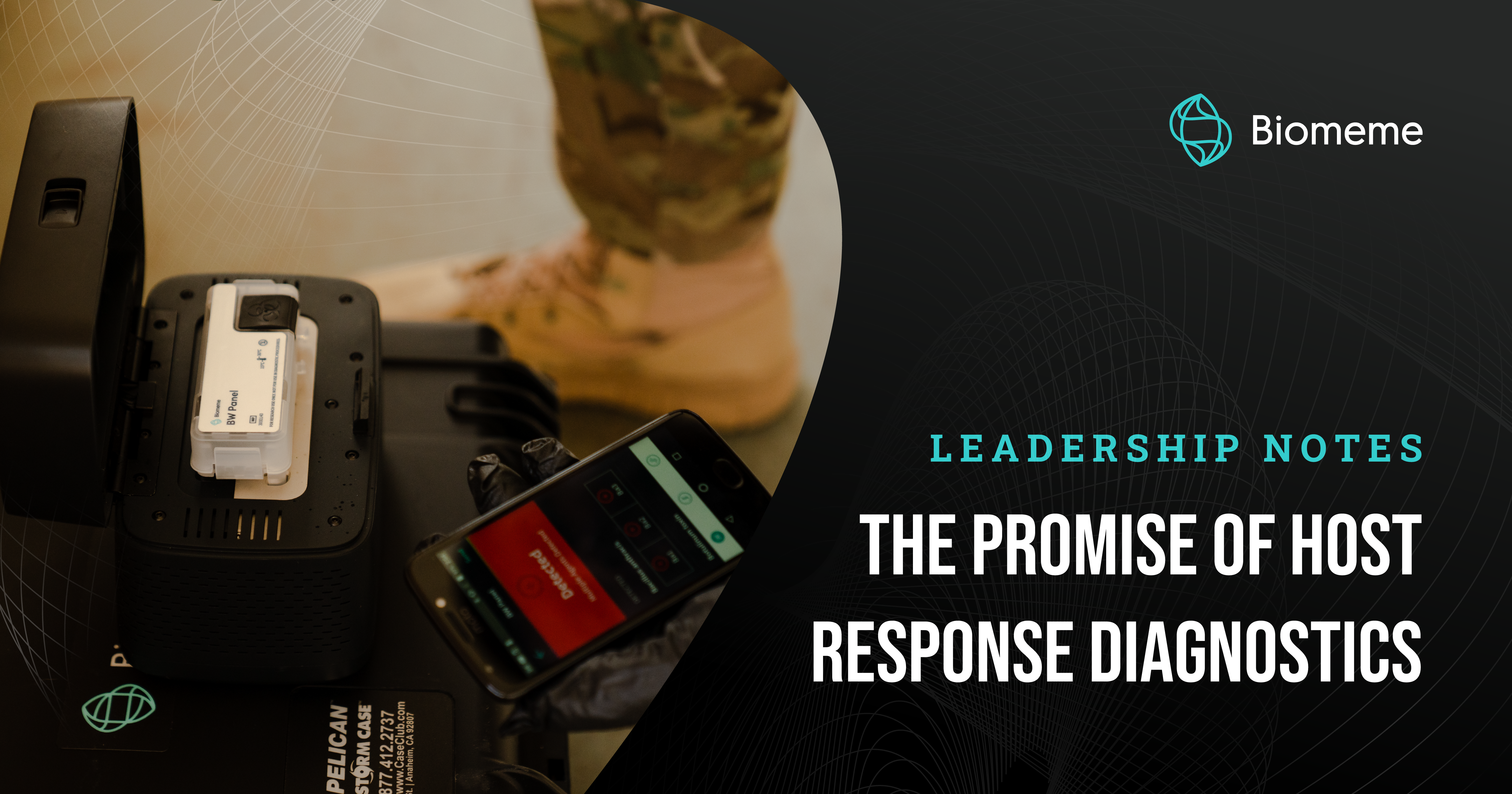The Immune System as a Home Security System
The Immune System as a Culinary Maestro
The Immune System as Context Clues
The Immune System as a Football Playbook
Host Response Diagnostics as Economic Indicators
Explaining the profound impact of Host Response in the context of One Health and the fight against antimicrobial resistance can be challenging.
Host response is the body's unique reaction to invaders like bacteria, fungi, or viruses. It triggers a tailored immune response, also known as a signature, determining the best course of action to combat the invader.
Understanding Host Response and being able to translate it into a tool to reliably detect and differentiate bacterial, viral, and fungal infections helps providers respond with a clear and accurate treatment plan based on actionable data.
While this only scratches the surface of its significance in healthcare, diagnostics, and One Health, let's explore five Host Response analogies to grasp the incredible complexity of the immune system in action. No single analogy here will fully encapsulate it, but taken together, they should provide a pretty good understanding of how amazing this function of the immune system really is.
The Immune System as a Home Security System
The Immune System as a Culinary Maestro
The Immune System as Context Clues
The Immune System as a Football Playbook
Host Response Diagnostics as Economic Indicators

Just like your home has various points of entry and areas to protect, your body has different points of vulnerability. Your immune system’s job is to keep a watchful eye on these vulnerable spots, much like security cameras covering your home’s entrances.
In this analogy:
A security system has different sensors and alarms to detect various threats, and similarly, your immune system has different sensors and responses to detect and combat various stressors (infections, injuries, or abnormalities). When a threat is detected by your security system, it triggers specific responses. For example, in the case of a break-in, alarms sound and security personnel are alerted. Similarly, when the immune system detects a bacterial infection, it triggers specific responses, such as the activation of immune cells and the release of antibodies.
Your immune system remembers past threats and learns from them, much like your security system stores information about past break-in attempts to enhance future security. Host Response diagnostics can be likened to the monitoring and analysis of data from your home security system. By understanding the signals and responses of the security system, you can identify the nature of the threat – whether it’s a break-in, a fire, or false alarm.

In this analogy:
When the body encounters a bacterial infection, it will flip to that section of its internal cookbook dedicated to this type of invader. The cookbook guides the body on which genes to activate, akin to assembling specific ingredients with the right mRNA targets. This process allows the body to prepare a tailored response to combat the infection effectively.
The power of host response diagnostics lies in understanding the chef's culinary prowess—the immune response—during these times of stress. By analyzing these responses, molecular tests can detect the presence of an infection or monitor disease progression. They help doctors distinguish between different types of infections, such as viral, parasitic, bacterial, or fungal, enabling precise and informed treatment decisions while avoiding unnecessary antibiotics.

Imagine you're learning a second language, and you come across words you don't understand. Looking up an unfamiliar word each time you come across one can be tedious and time-consuming. Instead of looking up each unfamiliar word, you rely on the language's grammar rules and context clues to grasp the overall meaning and continue reading. Your body's immune system operates much like using context clues when learning a new language.
For example, you may identify the word's part of speech based on its position in the sentence and infer the tone. Or, when you see a word several times and understand the words around it, you start to comprehend its meaning.
In this Host Response analogy, we treat infections like unfamiliar words in a foreign language:
Host response technology is like using context clues to decipher infections. We use the immune system’s rules (analogous to grammar rules) to detect and measure critical data, helping categorize infections (bacterial, viral, fungal, etc.). Symptoms and medical history act as the known words in a sentence, offering essential context for determining the likely source and potential consequences of an infection (or the general meaning of a word). Host Response tests, guided by healthcare providers, swiftly provide insights and initiate treatment, avoiding unnecessary antibiotic prescriptions and reducing wait times for results.

Each player on this team has a designated position and a unique role to play in the game. In this analogy:
Just like a sports team executing plays, Host Response diagnostics analyze how each player on your immune system team responds to threats. These responses help doctors identify the type of threat, whether it’s bacterial, viral, fungal, or something else entirely. Much like a well-coached sports team achieves better outcomes, Host Response diagnostics enable targeted treatments. Doctors can avoid unnecessary antibiotics and tailor interventions to the specific threat, leading to improved patient outcomes.

Here, we’ll make these comparisons to Host Response diagnostics as a whole and not necessarily the immune system response. Think of Host Response diagnostics as economic analysts who scrutinize various economic indicators to assess the economy's health and predict future trends.
In economics, we have indicators like the unemployment rate, GDP, and inflation to gauge the country's economic health. Similarly, your body has overall indicators, such as temperature, heart rate, and blood pressure, which provide a snapshot of your health.
In this analogy:
Host Response diagnostics provide a comprehensive view of your body's health, combining overall indicators with specific responses. This precision enables us to detect health issues early, leading to more effective treatments and better patient outcomes.
We're investing in Host Response diagnostics because, much like economic indicators, they help us understand your body's health with precision, paving the way for innovative healthcare solutions.
The Immune System as a Home Security System

Just like your home has various points of entry and areas to protect, your body has different points of vulnerability. Your immune system’s job is to keep a watchful eye on these vulnerable spots, much like security cameras covering your home’s entrances.
In this analogy:
A security system has different sensors and alarms to detect various threats, and similarly, your immune system has different sensors and responses to detect and combat various stressors (infections, injuries, or abnormalities). When a threat is detected by your security system, it triggers specific responses. For example, in the case of a break-in, alarms sound and security personnel are alerted. Similarly, when the immune system detects a bacterial infection, it triggers specific responses, such as the activation of immune cells and the release of antibodies.
Your immune system remembers past threats and learns from them, much like your security system stores information about past break-in attempts to enhance future security. Host Response diagnostics can be likened to the monitoring and analysis of data from your home security system. By understanding the signals and responses of the security system, you can identify the nature of the threat – whether it’s a break-in, a fire, or false alarm.
The Immune System as a Culinary Maestro

In this analogy:
When the body encounters a bacterial infection, it will flip to that section of its internal cookbook dedicated to this type of invader. The cookbook guides the body on which genes to activate, akin to assembling specific ingredients with the right mRNA targets. This process allows the body to prepare a tailored response to combat the infection effectively.
The power of host response diagnostics lies in understanding the chef's culinary prowess—the immune response—during these times of stress. By analyzing these responses, molecular tests can detect the presence of an infection or monitor disease progression. They help doctors distinguish between different types of infections, such as viral, parasitic, bacterial, or fungal, enabling precise and informed treatment decisions while avoiding unnecessary antibiotics.
The Immune System as Context Clues

Imagine you're learning a second language, and you come across words you don't understand. Looking up an unfamiliar word each time you come across one can be tedious and time-consuming. Instead of looking up each unfamiliar word, you rely on the language's grammar rules and context clues to grasp the overall meaning and continue reading. Your body's immune system operates much like using context clues when learning a new language.
For example, you may identify the word's part of speech based on its position in the sentence and infer the tone. Or, when you see a word several times and understand the words around it, you start to comprehend its meaning.
In this Host Response analogy, we treat infections like unfamiliar words in a foreign language:
Host response technology is like using context clues to decipher infections. We use the immune system’s rules (analogous to grammar rules) to detect and measure critical data, helping categorize infections (bacterial, viral, fungal, etc.). Symptoms and medical history act as the known words in a sentence, offering essential context for determining the likely source and potential consequences of an infection (or the general meaning of a word). Host Response tests, guided by healthcare providers, swiftly provide insights and initiate treatment, avoiding unnecessary antibiotic prescriptions and reducing wait times for results.
The Immune System as a Football Playbook

Each player on this team has a designated position and a unique role to play in the game. In this analogy:
Just like a sports team executing plays, Host Response diagnostics analyze how each player on your immune system team responds to threats. These responses help doctors identify the type of threat, whether it’s bacterial, viral, fungal, or something else entirely. Much like a well-coached sports team achieves better outcomes, Host Response diagnostics enable targeted treatments. Doctors can avoid unnecessary antibiotics and tailor interventions to the specific threat, leading to improved patient outcomes.
Host Response Diagnostics as Economic Indicators

Here, we’ll make these comparisons to Host Response diagnostics as a whole and not necessarily the immune system response. Think of Host Response diagnostics as economic analysts who scrutinize various economic indicators to assess the economy's health and predict future trends.
In economics, we have indicators like the unemployment rate, GDP, and inflation to gauge the country's economic health. Similarly, your body has overall indicators, such as temperature, heart rate, and blood pressure, which provide a snapshot of your health.
In this analogy:
Host Response diagnostics provide a comprehensive view of your body's health, combining overall indicators with specific responses. This precision enables us to detect health issues early, leading to more effective treatments and better patient outcomes.
We're investing in Host Response diagnostics because, much like economic indicators, they help us understand your body's health with precision, paving the way for innovative healthcare solutions.
Disclaimer: While we have used analogies to simplify the concept of Host Response, we acknowledge that these comparisons are not comprehensive representations of the scientific and technical intricacies involved. Our goal is to provide a simplified, accessible explanation of a complex topic. The analogies are intended to aid understanding rather than provide precise scientific accuracy.
With these analogies, we hope to convey the crucial role that Host Response diagnostics play in shaping the future of human health, modernizing medical diagnostics, and advancing patient care.
The precision of Host Response diagnostics empowers healthcare providers to make more informed decisions, leading to tailored treatment approaches that enhance patient outcomes and well-being.
Our ongoing commitment to Host Response diagnostics promises even more rapid advancements in data-driven healthcare solutions, accelerating the path to better patient results.

Biomeme CEO Max Perelman explains why host response testing has the potential to transform global health – starting...
401 North Broad St Suite 222 Philadelphia, PA 19108